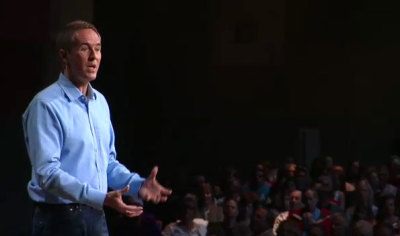To Pastor Andy Stanley: Jesus drew circles and lines

Author's note: As in all my dealings with Pastor Stanley, I shared this article with him privately before posting it publicly.
According to Pastor Andy Stanley, Dr. Al Mohler’s “version of Christianity draws lines, and Jesus drew circles. He drew circles so large, and He included so many people in His circle that it consistently made religious leaders nervous. And His circle was big enough to include sinners like me, and I come from a long line of sinners like me.”
Yes, “On one occasion, Jesus said, ‘Come to Me, all you who are weary and burdened, and I will give you rest. You will find rest for your souls. All. That’s a big circle. That’s the invitation of our Savior. That’s the invitation of our church.”
Indeed, as a church, Pastor Stanley stated, “we decided 28 years ago, we draw circles we don’t draw lines, we draw big circles.”
The truth is that Jesus drew both circles and lines, and if we don’t do both, we hurt those we are called to help.
On the one hand, God’s love, expressed in Jesus, is massive beyond words. Jesus died for our sins. He took the punishment for our guilt. He was pronounced guilty so that we could be pronounced righteous. What love! What grace! What mercy!
It is beyond anything we could have asked for or imagined, and it reflects the very character of our God. God Himself is love.
Talk about drawing big circles. Through Jesus, God extended His massive arms to the entire planet, to everyone who ever lived and will live, saying, “Come to Me and receive forgiveness. Come to Me and start a brand new life. Come to Me and find rest.”
That is our Savior. That is our God.
But, to quote retired Methodist bishop Robert M. Solomon, “The Bible speaks of the importance of drawing both lines and circles. It is not a question of ‘either-or’ but ‘both-and.’”
So, “In His relationships with those socially marginalized by common prejudice, Jesus drew circles of acceptance.”
We, in turn, should follow His practice.
Yet, Bishop Solomon adds, “if we draw only circles, ignoring spiritual and moral lines drawn by the divine Hand, then we are in danger of descending into a mindless, mushy, and sentimental form of religion that ends up rebelling against God.”
Precisely so. And not only do we end up rebelling against God, but we also mislead those we are called to help save.
That’s why the same Jesus who practiced transformational — not affirmational — inclusion, reaching out to the “sinners” of the day, also said this:
“Enter by the narrow gate. For the gate is wide and the way is easy that leads to destruction, and those who enter by it are many. For the gate is narrow and the way is hard that leads to life, and those who find it are few” (Matthew 7:13–14).
He also said this, just a few verses later in the very same sermon: “Not everyone who says to me, ‘Lord, Lord,’ will enter the Kingdom of Heaven, but the one who does the will of my Father who is in Heaven. On that day many will say to me, ‘Lord, Lord, did we not prophesy in your name, and cast out demons in your name, and do many mighty works in your name?’ And then will I declare to them, ‘I never knew you; depart from me, you workers of lawlessness’” (Matthew 7:21–23).
He also made statements like this:
“I tell you, many will come from east and west and recline at table with Abraham, Isaac, and Jacob in the Kingdom of Heaven, while the sons of the Kingdom will be thrown into the outer darkness. In that place there will be weeping and gnashing of teeth” (Matthew 8:11–12).
And this: “The Son of Man will send his angels, and they will gather out of his kingdom all causes of sin and all law-breakers and throw them into the fiery furnace. In that place there will be weeping and gnashing of teeth. Then the righteous will shine like the sun in the kingdom of their Father. He who has ears, let him hear” (Matthew 13:41–43).
And this: “When the Son of Man comes in His glory, and all the angels with Him, then He will sit on His glorious throne. Before Him will be gathered all the nations, and He will separate people one from another as a shepherd separates the sheep from the goats. And He will place the sheep on His right, but the goats on the left. Then the King will say to those on his right, ‘Come, you who are blessed by my Father, inherit the Kingdom prepared for you from the foundation of the world.” ... “Then he will say to those on his left, ‘Depart from me, you cursed, into the eternal fire prepared for the devil and his angels ... And these will go away into eternal punishment, but the righteous into eternal life” (Matthew 25:31–34, 41, 46).
Those certainly sound like lines — very clear, definitive lines. Some make it in while others are excluded — forever.
And what did He say to those who wanted to follow Him — those in the big circle to whom He reached out and for whom He died? Among other things, He said this: “If anyone would come after me, let him deny himself and take up his cross and follow me. For whoever would save his life will lose it, but whoever loses his life for my sake will find it” (Matthew 16:24–25).
And this: “If anyone comes to me and does not hate his own father and mother and wife and children and brothers and sisters, yes, and even his own life, he cannot be my disciple. Whoever does not bear his own cross and come after me cannot be my disciple ... So, therefore, any one of you who does not renounce all that he has cannot be my disciple” (Luke 14:26–27).
Regarding the Lord’s words to the common, everyday person, Luke records, “There were some present at that very time who told him about the Galileans whose blood Pilate had mingled with their sacrifices. And he answered them, ‘Do you think that these Galileans were worse sinners than all the other Galileans, because they suffered in this way? No, I tell you; but unless you repent, you will all likewise perish. Or those eighteen on whom the tower in Siloam fell and killed them: do you think that they were worse offenders than all the others who lived in Jerusalem? No, I tell you; but unless you repent, you will all likewise perish’” (Luke 13:1–5).
To the religious hypocrites, He said, “You serpents, you brood of vipers, how are you to escape being sentenced to hell?” (Matthew 23:33).
In short, Jesus said, “Whoever is not with me is against me, and whoever does not gather with me scatters” (Matthew 12:30).
And this is just a tiny sampling of the Lord’s words. He most certainly drew clear lines!
Bishop Solomon rightly asks, “How do we know when and where to draw lines and circles?”
His answer: “The best thing we can do is to stay close to Jesus.”
Yes, Jesus made Himself perfectly clear, drawing a massive circle that invited sinners of every sort and stripe (including you and me) and laying out clear lines as well.
To draw lines only is to fall into a legalistic, self-righteous religion that pushes sinners away. To draw circles only is to damn those same sinners to Hell.
Dr. Michael Brown(www.askdrbrown.org) is the host of the nationally syndicated Line of Fire radio program. His latest book isWhy So Many Christians Have Left the Faith. Connect with him on Facebook, Twitter, or YouTube.



























